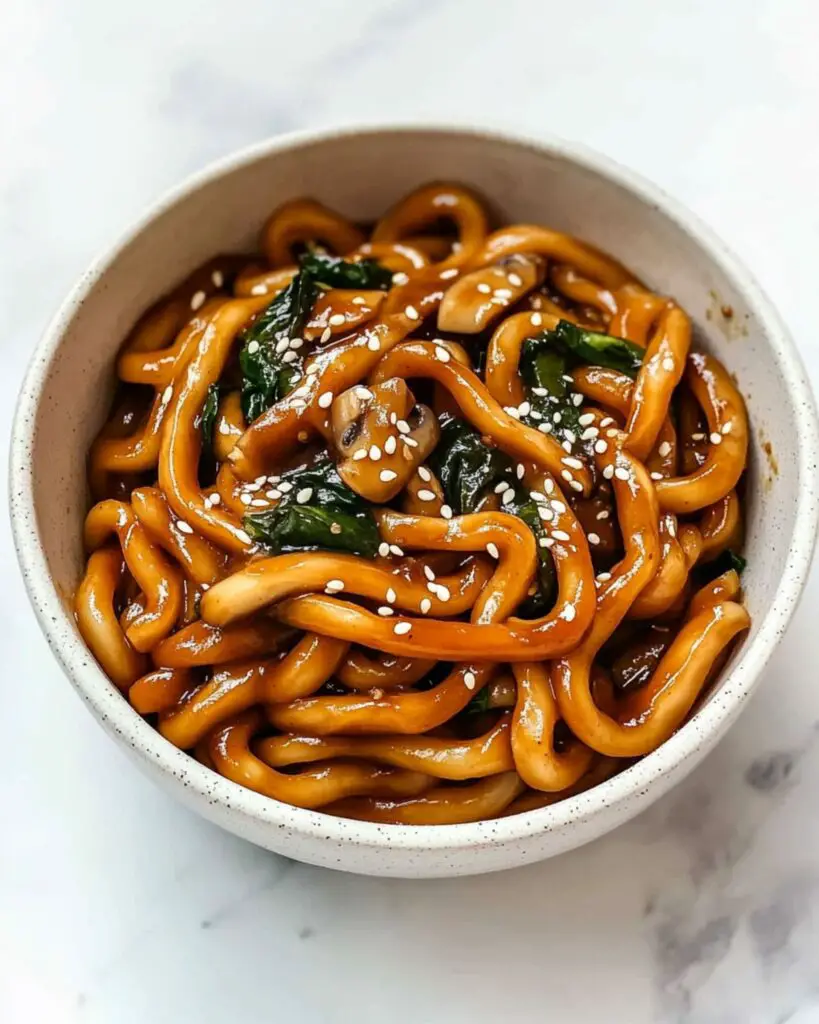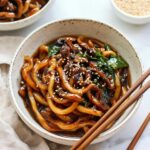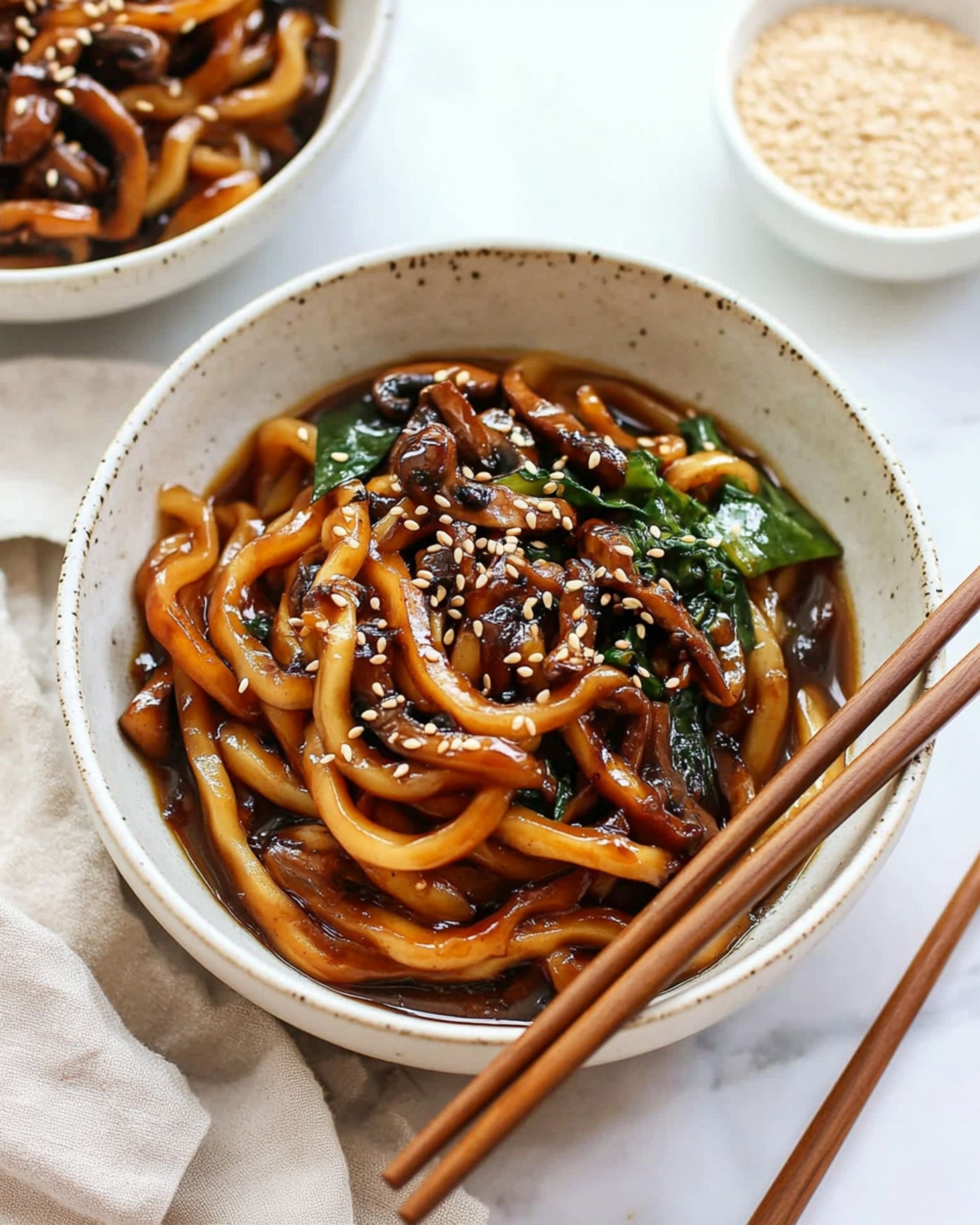If you’re yearning for a cozy, ultra-satisfying noodle dish that can be whipped up quicker than delivery, you’re in for an absolute treat. This Yaki Udon recipe is all about savory, slippery noodles, crisp-tender veggies, and bold umami flavors—all brought together in just 15 minutes. It’s approachable enough for a busy weeknight but so tasty, you’ll want to make it over and over again. From the glossy stir fry sauce to the hearty mushrooms and sweet-spicy notes, every bite is a delight. There’s no need for fussy steps or exotic gadgets—just simple ingredients, a skillet, and a hunger for something really, really delicious.
Why You’ll Love This Recipe
- Ridiculously Fast: From start to finish, you’ll have dinner on the table in 15 minutes. Faster than you can choose a takeout menu.
- Foolproof Simplicity: No tricky techniques, no hard-to-find ingredients. Even if you’ve never stir-fried before, this recipe holds your hand the entire way.
- Vegetarian-Friendly: All the deep flavors of Japanese comfort food without the meat, though it’s easy to customize.
- Deep, Satisfying Flavors: The combination of mushroomy richness, vibrant greens, and a sweet-savory sauce makes every mouthful crave-worthy.
- Perfect for Experimenting: Swap the veggies or amp up the spice—this dish is built for playful tweaks!
Ingredients You’ll Need
Here’s what you need to build magic in a pan—and a few tips for making each ingredient shine.
- Vegetable Oil: For stir-frying. Use a neutral-flavored oil with a high smoke point, like canola or sunflower, to keep the flavors clean.
- Scallions: Deliver a mild oniony punch and a pop of freshness.
- Garlic: Essential for aromatic depth. The more, the merrier.
- Shiitake Mushrooms: Provide an earthy, meaty quality that makes the noodles downright savory.
- Baby Bok Choy: Tender greens that wilt beautifully and add crunch. Chop just before cooking for maximum freshness.
- Udon Noodles: Thick, chewy wheat noodles are the heart and soul of yaki udon. Look for pre-cooked or frozen options for speed.
- Vegetarian Oyster Sauce: Brings that legendary umami. Regular oyster sauce also works if you’re not vegetarian.
- Dark Soy Sauce: For color and rich, caramel flavor.
- Light Soy Sauce: Lighter, saltier, and helps balance the sauce.
- Mirin: Sweet Japanese cooking wine. Sub with dry sherry or a dash of rice vinegar if needed.
- Honey or Agave: A touch of sweetness rounds out the sauce’s edges. Choose agave for a vegan-friendly dish.
- Sriracha: Adds a gentle, warming heat and extra depth.
Note: You’ll find the complete list of ingredients, along with their exact measurements, in the printable recipe card at the bottom of this post.
Variations
- Swap Your Greens: Try spinach, Napa cabbage, or even kale for a new texture.
- Protein Boost: Add strips of pan-fried tofu, sliced grilled chicken, or shrimp for extra oomph.
- Low-Heat Version: Skip or reduce the sriracha if you prefer no spice.
- Mushroom Medley: Swap shiitake for cremini, portobello, or whatever you have at hand for a slightly different flavor.
- Flavor Adventure: Toss in ginger, sesame oil, or chili crisp to make it your signature.
- Gluten-Free Option: Use rice noodles and gluten-free tamari or soy sauces.
Don’t be afraid to make it your own—no two noodle bowls need to be alike!
How to Make Yaki Udon
Step 1: Make the Sauce
Stir together vegetarian oyster sauce, dark soy sauce, light soy sauce, mirin, honey, and sriracha in a small bowl. Set this flavor-packed mixture aside within easy reach; things move fast once the pan gets hot.
Step 2: Sauté Aromatics
Heat vegetable oil over medium-high heat in a large skillet or wok. Toss in the chopped scallions and garlic, and let them sizzle for about a minute. You’re looking for a fragrance that fills the kitchen, not browning.
Step 3: Cook the Veggies
Add sliced shiitake mushrooms and chopped bok choy. Give everything a good stir so it’s coated lightly in oil. Let it cook for 3–4 minutes, just until the veggies become tender and the bok choy wilts down (it reduces more than you think—don’t worry!).
Step 4: Add Noodles and Sauce
Gently add your cooked udon noodles to the pan. Pour the sauce all over, then use tongs or chopsticks to toss everything together until the noodles are beautifully coated. Let the noodles sit for about 30 seconds without stirring to pick up a slightly caramelized, golden bottom—it’s those little bits that make all the difference.
Step 5: Serve Immediately
Remove from heat and serve hot, right from the pan! Slurping encouraged.
Pro Tips for Making the Recipe
- Don’t Overcrowd the Pan: If doubling the recipe, cook in batches so the veggies fry, not steam.
- Use Pre-Cooked Noodles: Instant or frozen udon saves time and delivers great texture.
- Let the Noodles Brown: Resist the urge to stir constantly—letting the noodles sit undisturbed for half a minute builds irresistible flavor.
- Tailor to Your Taste: Taste the sauce before adding—if you like it sweeter, add a bit more honey. Want punchier flavor? More soy sauce or a dash of rice vinegar can do the trick.
How to Serve

Yaki Udon can hold its own as a main dish, but it’s also wonderful with light, simple accompaniments:
- Garnishes: Finish with extra scallions, sesame seeds, or a splash of toasted sesame oil for nutty richness.
- Add Protein: Top with seared tofu, a runny-yolked egg, or thinly-sliced beef for a heartier meal.
- Side Dishes: Serve with miso soup, a quick cucumber salad, or pickled vegetables for balance.
- Extra Heat: Offer chili flakes or more sriracha on the side for those who crave spice.
Yaki Udon is meant for sharing—with friends, family, or just as a satisfying weeknight reward for yourself.
Make Ahead and Storage
Storing Leftovers
Place any leftover noodles in an airtight container in the fridge. They’ll keep well for up to 3 days, and the flavors actually deepen overnight.
Freezing
Not recommended—udon noodles don’t appreciate the freezer. They tend to lose their lovely chewy texture.
Reheating
Reheat gently in a skillet with a splash of water to loosen things up. The microwave works too—just cover and heat in short bursts, stirring in between, to keep the noodles from drying out.
FAQs
-
Can I use dried udon noodles instead of fresh?
Absolutely. Cook them according to the package instructions before adding them to the stir fry. Fresh or frozen noodles offer a more authentic chewy texture, but dried work in a pinch.
-
How do I prevent the noodles from clumping together?
If using fresh or frozen udon, quickly rinse under warm water to separate strands before adding to the pan. A touch more oil while stir-frying also helps keep everything loose and glossy.
-
Can I make this dish vegan?
Yes! Simply use agave instead of honey and confirm your oyster sauce is vegan (most vegetarian brands are). The dish is plant-powered and rich, even without animal products.
-
Can I add more vegetables?
Definitely—this recipe is wide open for additions. Bell peppers, carrots, snap peas, or thin strips of cabbage all work beautifully. Just adjust cooking time so everything stays crisp and vibrant.
Final Thoughts
There’s something instantly comforting about a steaming bowl of Yaki Udon—especially knowing you can have it ready in the time it takes to set the table. Don’t hesitate to experiment and let your favorite vegetables, sauces, or protein join the party. Simple, quick, and bursting with flavor, this recipe is proof that weeknight dinners can be both effortless and truly memorable. Give it a try and let the noodles do the talking!
Print
Yaki Udon (Quick & Easy Stir Fried Noodles) Recipe
- Prep Time: 5 minutes
- Cook Time: 10 minutes
- Total Time: 15 minutes
- Yield: 4 servings
- Category: Main-course
- Method: Stovetop
- Cuisine: Japanese
- Diet: Vegetarian
Description
Yaki Udon is a quick and easy Japanese stir-fried noodle dish featuring thick, chewy udon noodles tossed with sautéed vegetables in a savory, umami-rich sauce. Perfect for a satisfying weeknight dinner, this vegetarian-friendly recipe takes just 15 minutes to prepare and delivers authentic takeout flavor using simple pantry staples.
Ingredients
Stir Fry
- 2 tbsp vegetable oil
- 4 scallions, chopped
- 4 garlic cloves, chopped
- 1 cup sliced shiitake mushrooms
- 3 cups chopped baby bok choy
- 500 grams udon noodles, cooked according to package directions
Stir Fry Sauce
- 2 tbsp vegetarian oyster sauce (or regular oyster sauce)
- 1 tbsp dark soy sauce
- 1 tbsp light soy sauce
- 1 tbsp mirin (substitute with 1 tbsp dry sherry or 1 tsp rice vinegar)
- 1 tbsp honey or agave
- 1 tsp sriracha
Instructions
- Prepare the Sauce: In a small bowl, mix together the vegetarian oyster sauce, dark soy sauce, light soy sauce, mirin, honey (or agave), and sriracha until well combined. Set aside.
- Sauté Aromatics: Heat 2 tablespoons of vegetable oil in a large skillet over medium-high heat. Add the chopped scallions and garlic, cooking for about 1 minute until fragrant.
- Add Vegetables: Add the sliced shiitake mushrooms and chopped baby bok choy to the skillet. Sauté, stirring frequently, for 3-4 minutes until the mushrooms are tender and the bok choy has wilted significantly.
- Stir Fry Noodles: Add the cooked udon noodles and prepared stir fry sauce to the pan. Toss everything together to evenly coat the noodles and vegetables in the sauce. Let the noodles cook undisturbed for at least 30 seconds to allow slight browning on the bottom for added flavor.
- Finish and Serve: Remove from heat and serve immediately, garnishing with additional scallions if desired.
Notes
- Use fresh or frozen udon noodles for the best chewy texture.
- Customize the vegetables based on seasonal availability or personal preference.
- For more protein, add tofu or your favorite protein before adding the sauce.
- Adjust the amount of sriracha for more or less heat.
Nutrition
- Serving Size: 1 serving (approx. 1/4 of recipe)
- Calories: 375
- Sugar: 7g
- Sodium: 1140mg
- Fat: 9g
- Saturated Fat: 1g
- Unsaturated Fat: 7g
- Trans Fat: 0g
- Carbohydrates: 64g
- Fiber: 3g
- Protein: 9g
- Cholesterol: 0mg









